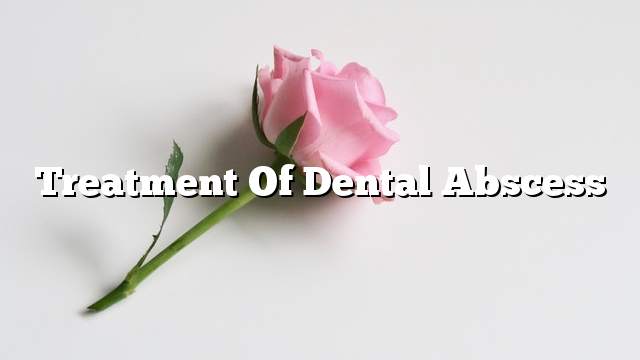Abscess of teeth
Is the collection of yellow matter resulting from the bacterial infection of the teeth, and this type of infection varies depending on where it is and the causes of occurrence, and these types of abscess around the Persian (Periapical abscess), which is the abscess that gets to the tip of the root of the tooth, usually occurs this type of abscess due to neglect Treatment of tooth decay, or exposure of teeth to blows or accidents, and periodontal abscess, which is the abscess that is formed in the gums and next to the roots of the teeth.
Causes of abscess teeth
Dental abscesses are caused by caries, necrosis or broken tooth structure. The presence of openings in the tooth enamel allows the bacteria to enter the teeth and become infected with inflammation. This infection may spread from the roots of the teeth to the supporting bones of the teeth and sometimes lead to swelling of the area. There are other reasons that may lead to inflammation and tooth abscess, including some dental treatments, such as artificial dental crowns, or deep fillings close to the pulp of the teeth, and the exposure of teeth to the blows as a result of grinding food or friction with each other may lead to abscess.
Home procedures before you see your doctor
In case of dental abscess the patient should perform the following procedures to relieve the pain until the dentist visits:
- Avoid being exposed to very high or very low temperatures by eating foods and drinks at moderate temperatures, sitting in a place with a moderate temperature, and avoiding staying in cold places.
- Lie down in a mile and do not lie horizontally, because that helps relieve the pain.
- The use of clove oil to relieve pain, as this oil has therapeutic properties and the ability to relieve pain, and can be used tea tree oil and mint oil to protect against mouth bacteria.
- Use saline solution in the rinse, to help heal after dental procedures at the dentist.
- Although the teeth are sensitive to high and low temperatures, putting cold water or ice packs on the affected area will relieve the pain.
- It should be noted that these procedures are not a treatment for dental abscess, and can not be relied upon alone, they are used only as preventive measures not more.
Treatment of dental abscess
The aim of the treatment of dental abscess is to get rid of inflammation, and this is done through the dentist to open the gums and discharge abscess, where the doctor cut in the swelling area to facilitate the exit of the abscess or yellow matter of inflammation, and then wash the area with brine.
It is also possible to treat the pulp of the teeth, and here the doctor removes all the damaged tissue including the pulp of the teeth, and helps to exit the abscess material of the same age, and then close the root channels, and in cases where it can not maintain the age is taking off the tooth, On the exit of the remaining material abscess.
Antibiotics may be used to treat inflammation if the infection is spread to neighboring teeth or in the jaw areas. If the abscess is confined to the inflammation area or confined to one area, antibiotics are not needed.
The patient is advised to enter the emergency room if the infection is rapid and accompanied by high body temperature or swelling in the face, especially in the absence of a dentist. If the infection is accompanied by shortness of breath or swallowing, entry into the emergency room is necessary. If children with temporary teeth are exposed to this type of infection, the most appropriate treatment in this case is to remove the infected white teeth to get rid of the inflammation. Elimination of the infection is very important so that permanent teeth are not affected.
Symptoms of abscess teeth
There are many symptoms associated with tooth abscess, the most important of which are the following:
- Pain is severe and continuous and is in the form of palpitations and may extend pain to feel the patient in the neck or ear or jaw.
- Swelling in the face or cheek.
- Sensitivity of teeth when exposed to cold or hot foods or beverages.
- Pain when chewing or pressing on the affected tooth.
- Pain and swelling in the lymph nodes adjacent to the affected area.
- Feeling odorless, tasteless, or feeling salty in your mouth.
- Feeling uncomfortable or general tenderness.
- High body temperature.
Complications of dental abscess
In the absence of dental abscess the patient may be exposed to one of the following complications:
- Loss or loss of infected teeth.
- Bacteremia.
- The spread of inflammation to surrounding tissues.
- The spread of inflammation to the jaw bones.
- The spread of inflammation to other parts of the body, for example may extend inflammation to the brain to be an abscess in the brain tissue, or inflammation of the heart muscle, or inflammation of the lungs.
Prevention of dental abscess
The prevention of dental caries is the main way to prevent the formation of dental abscess and prevent its formation, and to preserve the teeth and protect them from decay, the following instructions must be followed:
- Clean the teeth at least twice a day and use a toothpaste containing fluoride in the cleaning process.
- Use a dental floss or any method of cleaning between the teeth on a daily basis.
- Change your toothbrush every three to four months.
- Eat healthy foods while trying to reduce the intake of sugars.
- Treatment of tooth decay as soon as it appears.
- stop smoking.
- Periodic visits to the dentist.
